Spinning Glass To See The Stars
11:34 minutes
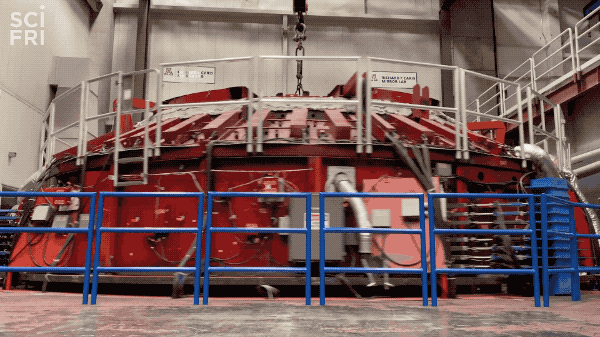
Last weekend, a giant furnace built under the east stands of the University of Arizona football stadium began to spin. That furnace contained some 20 tons of high-purity borosilicate glass, heated to 1,165 degrees C. As the glass melted, it flowed into gaps in a mold. The centrifugal force of the spinning furnace spread the material up the edges of the mold, forming the curved surface of a huge mirror, with a diameter of 8.4 meters.
The piece is just one of seven sections that will eventually form the 25-meter primary mirror of the Giant Magellan Telescope in Chile. It’s not a fast process—it will take several months to cool, and then another two years to measure, grind, and polish. When that’s complete, the surface of the mirror segment will be accurate to within twenty-five nanometers. Steward Observatory mirror polishing program project scientist Buddy Martin says that when it’s complete, the Giant Magellan Telescope should be ten times sharper than the Hubble Space Telescope—if it was positioned in Washington, DC, it would be able to make out a softball in the hand of a pitcher in San Francisco.
Martin talks with SciFri’s Charles Bergquist about the mirror production process, and the challenges of working with glass on massive scales. Watch a video and see photos of the process below.
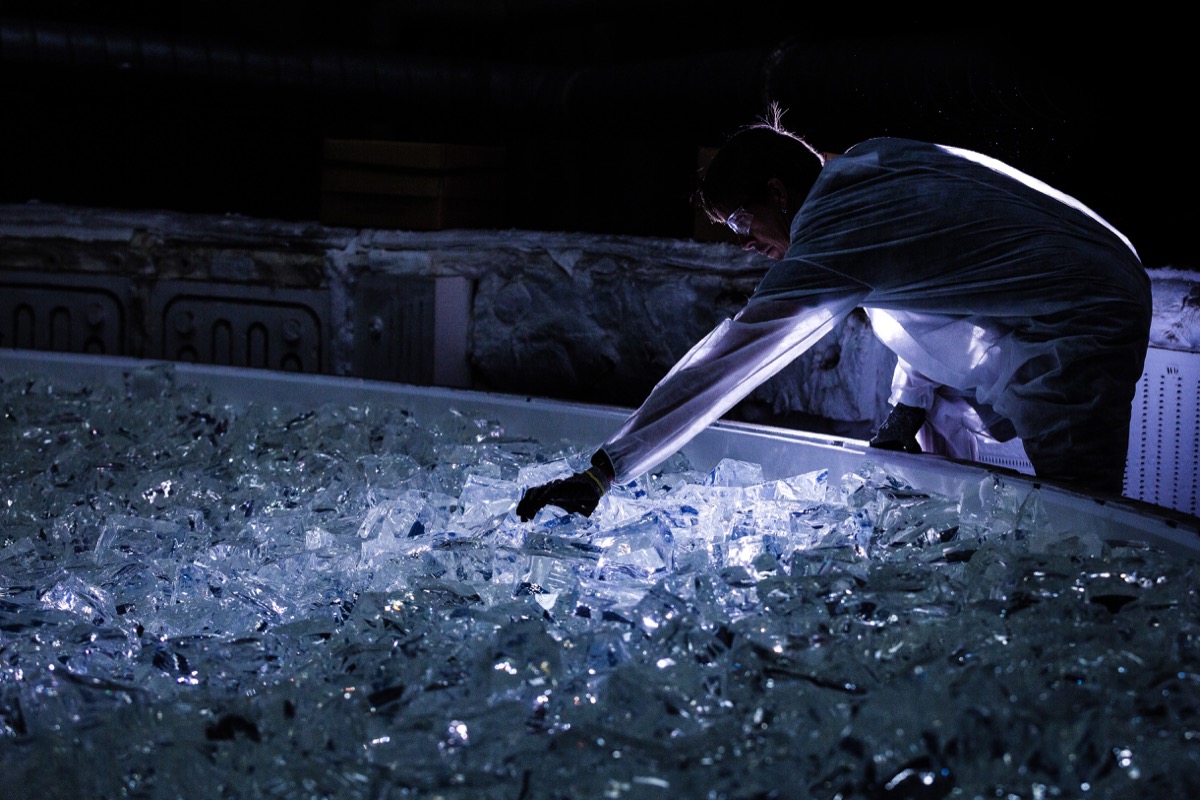
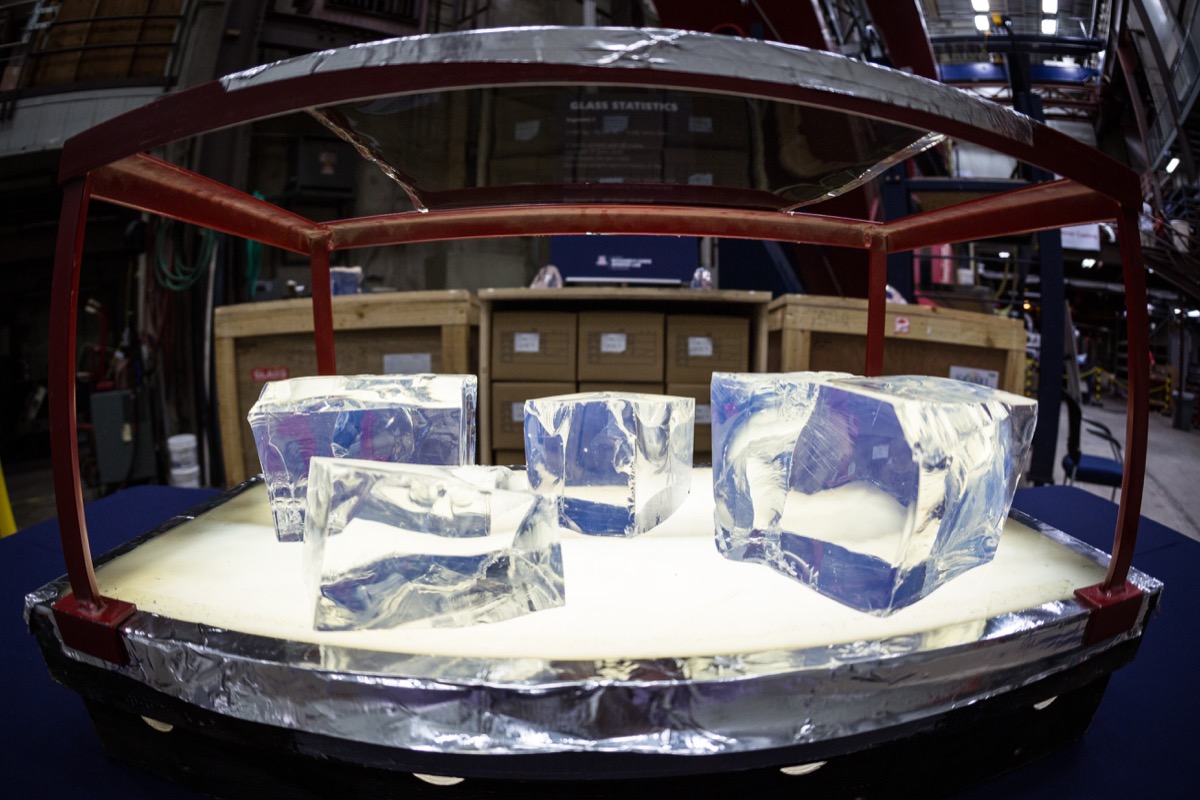
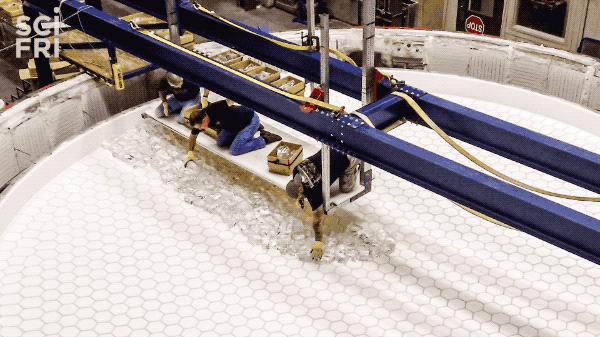
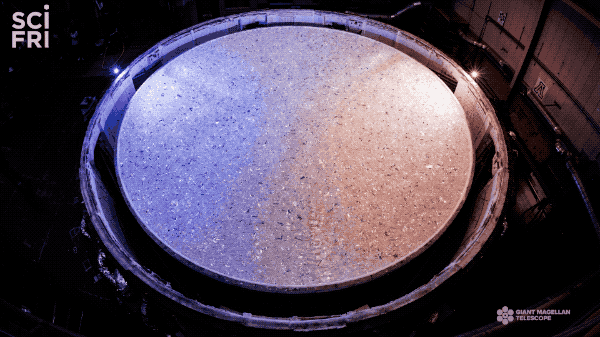
Invest in quality science journalism by making a donation to Science Friday.
Hubert (Buddy) Martin is Project Scientist at the Mirror Polishing Program and Associate Research Professor, Optical Sciences Ph.D., 1983, Cambridge University
JOHN: Turning now to a giant optical engineering project, here’s SciFri’s Charles Bergquist. Hi, Charles.
CHARLES BERGQUIST: Hey, John. I know you’re always up for a good game of name that sound. And I have a fun one for you.
JOHN: Oh, name that sound is one of my favorites.
CHARLES BERGQUIST: OK, well, here it comes.
[STRANGE SOUND EFFECT]
Any guesses?
JOHN: It’s a beautiful sound if you listen really closely. Now I can imagine it being part of a sound installation at an art gallery. But it could also just be a vacuum cleaner.
CHARLES BERGQUIST: Close, but it’s actually sound recorded last weekend of about 20 tons of glass getting heated up to 1,165 degrees Celsius in a giant, rotating furnace, located underneath the east stands of the University of Arizona football stadium. I think if you listen very carefully, you can hear that part.
JOHN: I was going to say, that’s exactly what it sounds like now. Now that you say that–
CHARLES BERGQUIST: This thing– it looks something like if you turned the designs of your standard fairgrounds carousel with the horses, turned it over to a bunch of science fiction art designers. It’s this big, rotating, red, cyberpunk-looking thing. And if you listen carefully to the whirr, you might be able to decode that it’s spinning at about five revolutions per minute. It’s all part of the slow process for casting a giant mirror.
JOHN: Wow. So there’s a lot there. There’s a rotating furnace, and it’s under a football stadium. But I guess I should ask you first, what’s this mirror for?
CHARLES BERGQUIST: So this is one of six identical, curved mirrors that will eventually get installed in the Giant Magellan Telescope. That’s a huge optical telescope being built in Chile that’s planned to see light not till late this decade.
JOHN: So you say a Giant Magellan Telescope, like, how giant is it?
CHARLES BERGQUIST: The primary mirror is 25 meters across. And there’s no real process for making a mirror that big. So that’s why they have to do it in pieces. These six curved mirrors are arranged like flower petals around a central point. And each of those mirror segments is 8.4 meters across. That’s like 27 feet for the metrically challenged.
JOHN: Wow. So they pour molten glass into a bowl shape to cast this?
CHARLES BERGQUIST: So that was my first guess, or that maybe they somehow carved it out of a large chunk. And it turns out both of those ideas are completely wrong. If you go to our website at sciencefriday.com, you’ll see a video of people preparing for last weekend’s melt by stacking hundreds of these hexagonal boxes into a giant, circular mold. I talked with Dr. Buddy Martin, project scientist for the Mirror Polishing Program at the Steward Observatory at the University of Arizona in Tucson, about just how this mirror casting process works.
DR. BUDDY MARTIN: If you imagine starting with a solid disk of glass that’s 28 feet in diameter and more than two feet thick, first, you would carve out the top surface to make it concave. It’s nine inches deep in the center. And then, you want to make the mirror much lighter than it is. So you would grind out the hexagonal cavities in this disk.
Well, all that grinding would be prohibitively expensive and very risky. So we melt the glass and cast it in that structure. The boxes will form the cavities of the honeycomb. And in order to get the curved top surface, the optical surface, we spin the furnace while the glass is molten, so that the centrifugal force will push it out and up the sides of the mold to give us that concave surface, which is approximately the curvature that’s necessary for this telescope.
CHARLES BERGQUIST: So the key components of the glass structure here is it needs to be strong, it needs to be stiff, and it needs to be lightweight.
DR. BUDDY MARTIN: Right. Stiffness against the wind and stiffness against gravity are the two most important features of the mirror. That’s what makes a good telescope mirror. Because if it doesn’t have that, it won’t be able to hold its shape accurately in the telescope. You can polish it to a very accurate shape in the lab. But in the telescope, it’s going to get hit by 20 mile per hour winds. It’s going to be pointed in different directions, as a telescope points to different objects around the sky. And so gravity is trying to bend it also.
CHARLES BERGQUIST: I understand you’re using a kind of glass called borosilicate glass for this. That’s the same material I might find in my kitchen measuring cups or a pie plate, or something like that.
DR. BUDDY MARTIN: Exactly. And it’s used for baking dishes for the same reason it’s used for mirrors. And that is, that it doesn’t expand very much with changes in temperature compared with other types of glass like plate glass. It expands very little. And that’s a valuable property for a telescope mirror, as well as a baking dish.
We get the borosilicate glass from the Japanese company Ohara. And one of the reasons it’s perfect for our application is that they melt the glass in one-ton clay pots and then carefully break each ton of glass into a few hundred small pieces. So that they have such pristine fracture surfaces, that they meld together with no trace of the individual blocks. And that’s a difficult thing to achieve when you melt pieces together.
CHARLES BERGQUIST: The peak heating process took place last weekend. But I understand the glass is still going to be very warm for some months to come. Why is that?
DR. BUDDY MARTIN: At that point, the glass is solid. It’s not going to change its shape, so we can stop the furnace rotation. But it’s still soft at the atomic scale. The atoms will finally get locked in place at about 500 degrees C. And it’s essential that the mirror’s very uniform in temperature while that’s happening.
So we achieved that by cooling it very slowly, two and 1/2 degrees C per day for about a month. Another month and a half, we’ll bring it down to room temperature, around June 1st. And we’ll take apart the furnace, take apart the outer parts of the mold, and get our first good look at this mirror.
CHARLES BERGQUIST: This is Science Friday from WNYC Studios. I’m talking with Dr. Buddy Martin of the University of Arizona about manufacturing a giant telescope mirror. I was reading that once this is cool, it’ll take something like two years to polish it. What’s going on there?
DR. BUDDY MARTIN: Yeah, that’s right. Well, that’s all about improving the accuracy. The mirror comes out of the casting operation with the surface accurate to, say, two and 1/2 millimeters on average. And over those two years of grinding and polishing, we’re gradually going to improve the surface to an accuracy of 25 nanometers. So that’s an improvement by a factor of 100,000.
And it just takes time to gradually improve the surface. I don’t have a good feel for what 25 nanometers or a millionth of an inch is. And I’m not sure anybody does. So I like to think of it as if the mirror were expanded to the size of North America, 3,500 miles in diameter. In that case, the average hill would be just 17 millimeters, 2/3 of an inch tall, and the average valley, 2/3 of an inch deep.
That’s how smooth this mirror has to be in order to form images that are as sharp as nature allows. And that’s why it takes two years to polish this.
CHARLES BERGQUIST: How sharp an image is that compared to what we have available today?
DR. BUDDY MARTIN: If you allow me to stick to this continental description of things, if the telescope were located in Washington DC, which nobody would want to do, but suppose it were there. Then, it could resolve a softball in San Francisco. It would see that as distinct from the arm that’s holding it.
Sharpness, or angular resolution of a telescope, scales with its diameter. And that’s a fundamental property of light related to the wave nature of light. So that’s what I mean when I say images as sharp as nature will allow. Some of the most spectacular images that any of us have seen are made with the Hubble Space Telescope, which is 2 and 1/2 meters in diameter. Well, the GMT is 25 meters in diameter. So its images will be 10 times as sharp as those of the Hubble Space Telescope.
CHARLES BERGQUIST: So when I think of my mirror at home, it’s got this reflective surface. Can you tell me about how that ends up on this mirror?
DR. BUDDY MARTIN: Most mirrors at home, say bathroom mirrors, have the reflective coating on the back of the mirror. It’s protected that way. But for a telescope mirror, you can’t afford to let the light go through the glass. We usually think of glass as an optical material, because light goes through glass, and we make lenses out of glass.
But for a telescope mirror, we’re just using glass as a structural material that can be polished to a very precise and accurate surface. The whole purpose of this huge piece of glass is to hold that layer of aluminum up. It’s only 4 millionths of an inch thick, about 1,000 atoms thick. And the mirror’s job is to hold that reflective coating in the right shape, at all times, through all perturbations that occur in the telescope.
CHARLES BERGQUIST: This mirror is the sixth of seven. Are there five others sitting in a warehouse somewhere?
DR. BUDDY MARTIN: They’re not all in a warehouse. There are two of them in a storage facility in Tucson. And we are polishing the third one now. Hope to be finished with that sometime this calendar year. The fourth and fifth are in various stages of fabrication in the mirror lab. And this was the sixth that was cast this weekend.
Since it does take us three or four years to make one of these mirrors, it’s important that we can work on more than one mirror at a time. We’re typically working on three or four mirrors simultaneously at different stations and at different stages in the manufacture.
CHARLES BERGQUIST: And when does the seventh mirror get made?
DR. BUDDY MARTIN: I understand that it will be cast in 2023, roughly two years.
CHARLES BERGQUIST: Well, good luck both with completing this mirror and mirror number seven. Dr. Buddy Martin is project scientist for the Mirror Polishing Program at the Steward Observatory of the University of Arizona in Tucson. For Science Friday, I’m Charles Bergquist.
Copyright © 2021 Science Friday Initiative. All rights reserved. Science Friday transcripts are produced on a tight deadline by 3Play Media. Fidelity to the original aired/published audio or video file might vary, and text might be updated or amended in the future. For the authoritative record of Science Friday’s programming, please visit the original aired/published recording. For terms of use and more information, visit our policies pages at http://www.sciencefriday.com/about/policies/
As Science Friday’s director and senior producer, Charles Bergquist channels the chaos of a live production studio into something sounding like a radio program. Favorite topics include planetary sciences, chemistry, materials, and shiny things with blinking lights.